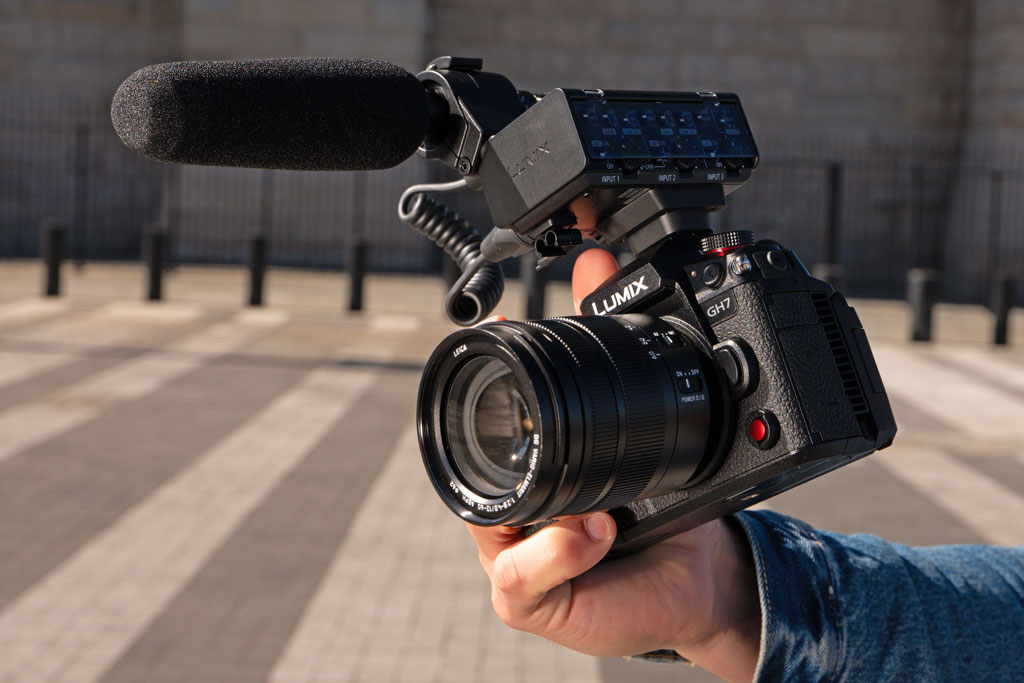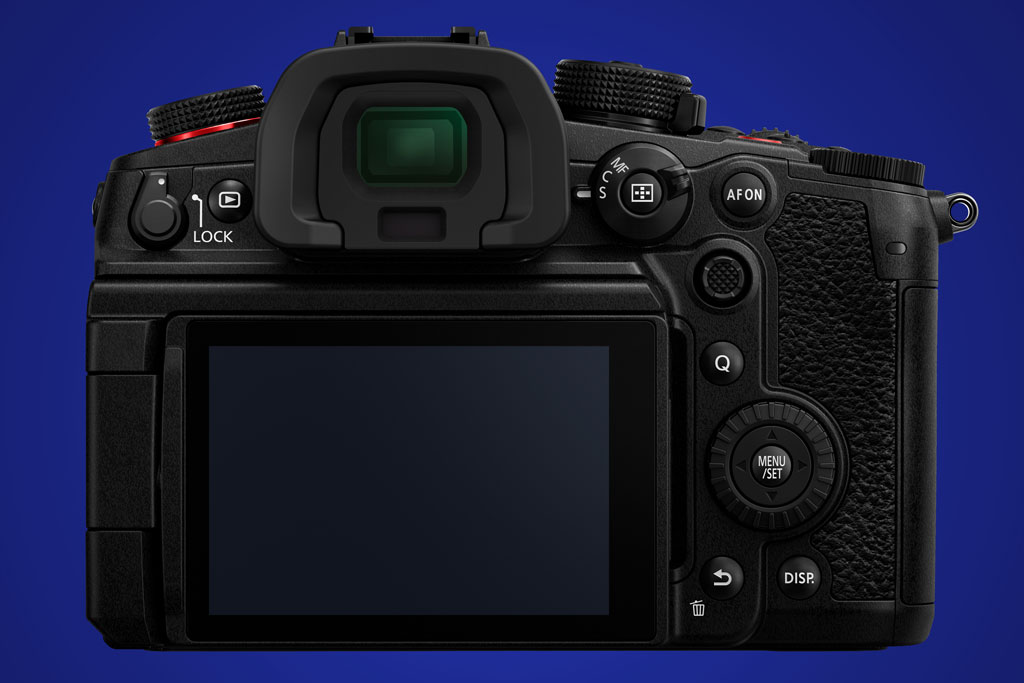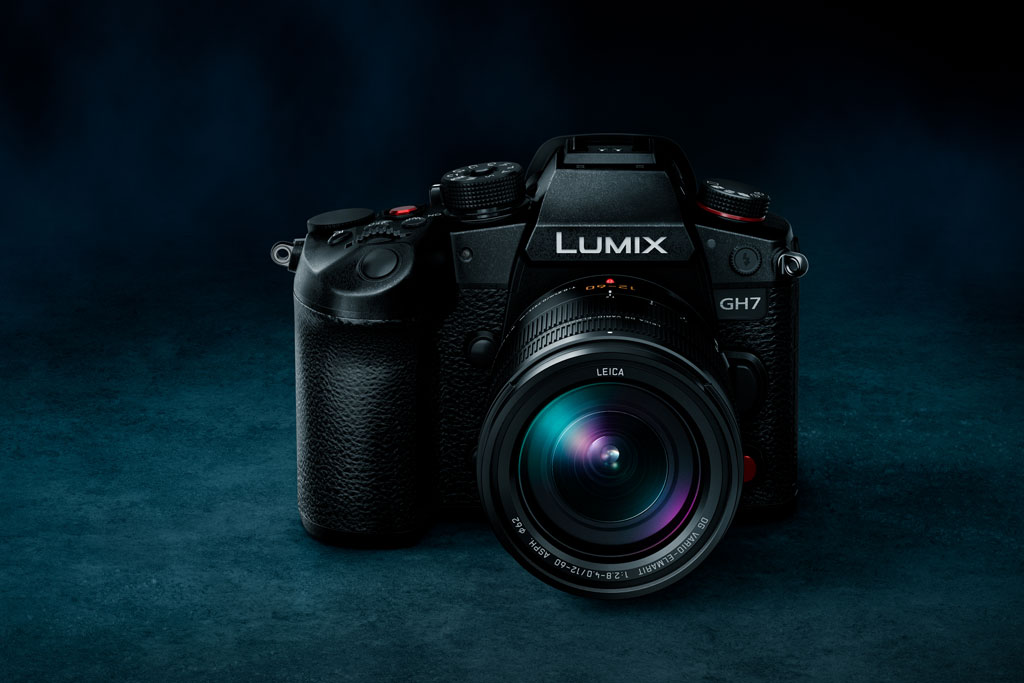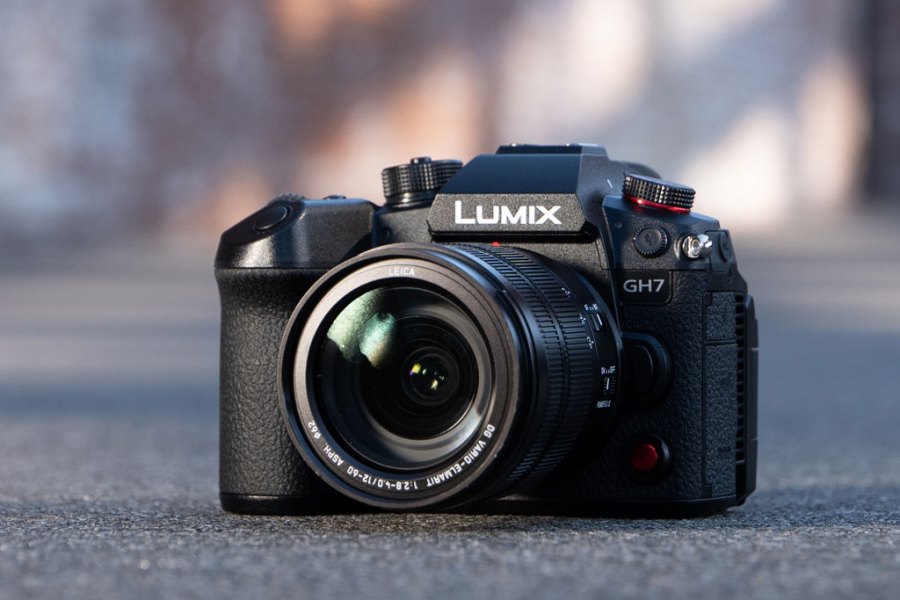Panasonic has launched a new video-focused Micro Four Thirds camera, the Lumix GH7. Designed for content creators and small video production teams, the new model looks almost identical to its predecessor, the GH6. However it gains a whole slew up video-related updates, to the extent that Panasonic describes the GH7 its first true ‘cinema camera’.
Panasonic Lumix GH7 at a glance:
- $2199 / £1999 body-only
- 5.8K 30p; 5.7K 60p; 4K 120fps; FullHD 240fps
- Internal Apple ProRes Raw recording
- 32-bit float audio support (via DMW-XLR2)
- Enhanced in-body image stabilisation
- Phase detection autofocus
- Subject recognition for humans, animals, and vehicles
Key features include internal Apple ProRes RAW recording in 5.7K resolution at 30fps (or 4K/60fps), and 32-bit float audio recording via the optional DMX-XLR2 microphone adapter announced alongside.
The camera is also capable of 5.8K/30fps ‘open gate’ recording using the full 4:3 aspect ratio output of the sensor, enabling post-capture cropping to different aspect ratios. A built-in fan promises practically unrestricted recording times.
Like Panasonic’s other recent cameras, the GH7 also benefits from the addition of on-sensor phase detection for autofocus, which makes an appearance on a GH-series model for the first time.

Expanded subject detection is available, which can recognise humans, animals, and vehicles. But now it aims to identify and focus on the most important element, such as the cockpit of a plane or the rider on a motorcycle.
There are two memory card slots, one for CFexpress Type B (which is required for internal recording at the maximum 800Mbps bit-rate) and the other for UHS-II SD cards. The GH7 is also capable of recording directly to an external SSD, via its 10Gbps USB-C port.
Panasonic’s real-time LUT feature is included, supported by with the firm’s latest Lumix LAB smartphone app. Other advanced video features include Frame.io support and proxy file recording for easier editing workflow.

For stills photography, the camera offers 25.2MP resolution, with a standard sensitivity range of ISO 100-25,600. It can shoot at up to 75 frames per second with focus fixed, or 60fps with continuous AF, with a buffer depth of 165 frames when shooting JPEG+raw.
In-body image stabilisation promises 7.5 stops of shake reduction when shooting stills and supports Dual IS 2 for use with optically stabilised lenses.
In design terms, the GH7 employs essentially the same control layout at its predecessor, the Lumix GH6. Panasonic is promising its usual robust construction, too, including dust, splash, and freeze resistance to -10 °C.

The GH7 incorporates a 3.68m-dot electronic viewfinder that offers 0.8x magnification, plus a 3in, 1.84m-dot touchscreen on the back which combines both up/down tilting and side-hinged fully-articulating mechanisms. This allows the screen to be positioned at practically any angle for maximum flexibility, and pulled clear of the various connector ports.
The Panasonic Lumix GH7 is due towards the end of July and will cost £1999.99 body-only.
Follow AP on Facebook, Twitter, Instagram, YouTube and TikTok.
Panasonic Lumix GH7: Full Specifications
| Sensor | 25.2MP CMOS, 17.3 x 13mm |
| Output size | 5776 x 4336 |
| Focal length mag | 2x |
| Lens mount | Micro Four Thirds |
| Shutter speeds | 60-1/8,000sec (mechanical) 60-1/32,000sec (electronic) |
| Sensitivity | ISO 100-25,600 (standard), ISO 50 25,600 (extended) |
| Exposure modes | PASM, Auto, Movie, C1-C4 |
| Metering | Multi, centre-weighted, spot, highlight |
| Exposure comp | +/-5EV in 0.3EV steps |
| Continuous shooting | 15fps AFS/MF; 10fps AFC (mechanical) 75fps AFS/MF; 60fps (electronic) |
| Screen | 3in, 1.84-m dot |
| Viewfinder | 3.68m-dot OLED, 0.8x |
| AF points | TBC |
| Video | 5.8K 30p; 5.7K 60p; 4K 120fps; FullHD 240fps |
| External mic | 3.5mm stereo; XLR via DMW-XLR2 |
| Memory card | 1x CFexpress Type B, 1x UHS-II SD |
| Power | DMW-BLK22 Li-ion, |
| Battery life | At least 330 shots |
| Dimensions | 138.4 x 100.3 x 99.6mm |
| Weight | 805g inc battery + SD card |
From Panasonic:
Panasonic Announces New LUMIX GH7 Micro Four-Thirds Mirrorless Camera

Panasonic is proud to introduce the new LUMIX GH7 – the latest flagship model of the Micro Four Thirds mirrorless LUMIX G Series.
Wiesbaden, 5th June 2024: The LUMIX GH7 delivers outstanding video performance, wide dynamic range with a newly developed 25.2MP BSI CMOS sensor, and improved AF performance with PDAF (Phase Detection Auto-Focus). To support the efficient workflow required in professional production environments, the GH7 is newly equipped with Apple ProRes RAW*1 internal recording and the World’s first 32-bit float recording*2, which eliminates the need to adjust sound recording levels during shooting.
With the rapid increase in demand for video content in recent years, the number of small teams of video creators is rising, along with the demand for further improvements in the quality of mirrorless cameras with excellent video performance and portability. Since its release in 2009, our LUMIX GH series has developed a strong reputation among creators and video production teams as a model renowned for its shooting performance, innovative features and reliability.
The LUMIX GH7 is a next-generation mirrorless camera that meets the needs of creators, whatever their creative field may be.
The LUMIX GH7 will be available at the end of July 2024, with an RRP of £1999.99
High performance, fast response, and excellent mobility
- 25.2MP BSI CMOS sensor with high resolution and fast response, along with 13+ stop dynamic range boost*3 with rich gradation
- Adopting PDAF for high-speed, high-precision AF performance, and newly added real-time auto-focus recognition AF for airplanes and trains
- Improved image stabilization technology, including perspective distortion correction for videos and High mode in Active I.S. to enable powerful compensation when shooting on the move
Enhanced video quality and optimized workflows from shooting to post- production
- Internal recording of 5.7K 30p ProRes 422 HQ and ProRes RAW HQ*1.
- World’s first 32-bit float recording*2, eliminating the need to adjust audio recording levels during shooting when using the new XLR microphone adapter, DMW-XLR2 (sold separately). The LUMIX DMW-XLR2 will be available at the end of July 2024, with an RRP of £499.99
- Allows users to load original LUT files and apply new color looks directly to videos and photos with REAL TIME LUT.
- Enables proxy recording for workflow efficiency and supports native Camera to Cloud integration with Adobe’s Frame.io, enabling images and videos to be automatically uploaded, backed up, shared, and worked on jointly via the cloud.
- Open Gate recording to enable flexible framing for any social media platform or client needs.
Reliable in the field video production
- Unlimited video recording made possible with efficient heat dissipation processing and the integration of a cooling fan*4.
- Convenient tilt-free angle monitor that does not interfere with HDMI or USB cables when tilted
- Able to withstand harsh environments with dust, splash resistance*5, and freeze-resistance down to – 10 degrees Celsius/14 degrees Fahrenheit.
*1 Recording is not possible on the SD card.
*2 For an interchangeable lens digital camera, as of June 5th 2024. According to Panasonic’s research. When used with the XLR microphone adapter DMW-XLR2 (sold separately).
*3 Dynamic Range Boost is not activated when shooting HFR/VFR video of 61fps or higher, or with SH burst shooting. Also not activated at shutter speeds slower than 1/15 during still image shooting, depending on the ISO. When shooting video over 60 fps (including VFR), latitude will be 12+ stop.
*4 When shooting at C4K/60p or lower. There are temperature restrictions for resolutions exceeding Cinema4K, VFR/HFR, and ProRes. Recording time depends on battery and memory card capacity.
*5 Dust and Splash Resistant does not guarantee that damage will not occur if this lens is subjected to direct contact with dust and water.






